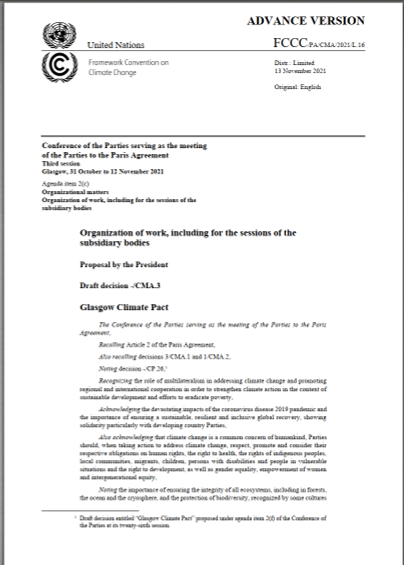After the dramatic final hours of negotiations, the most important issues at COP26 in Glasgow have now been decided. The decisions have led to key steps forward in international climate policy, but they are not enough to achieve the climate goals. (This is a translation of the original Swedish-language post that can be found here)
When it comes to emissions reductions there are clear statements about the importance of limiting warming to 1.5 degrees, which in practice means a stronger interpretation of the goal from the Paris Agreement. Parties will now sharpen their NDCs more often and in coordination with the pact. Global emissions reductions of 45% from 2010 to 2030 has been quantified, agreed upon and included in the text. The use of coal and fossil fuel subsidies will also be reduced, a first for international climate agreements. The agreements reached at Glasgow also included the implementation of emissions trading schemes in line with the Paris Agreement.
In addition to the Glasgow agreement itself, known as the Glasgow Climate Pact, groups of countries have also agreed on measures relating to, among other things, methane emissions, deforestation and coal power. Several countries have also advanced their positions, the most significant being India’s commitments to Net Zero by 2070. Overall, there was a sense of cooperation and ambition in the negotiations.
These decisions and promises will, at best, mean that global warming will evidently reach at 1.8-1.9 degrees, according to preliminary calculations. This is a great improvement from what it looked like before the start of COP26 and even more so compared to when the Paris Agreement was adopted in 2015.
But the progress is not nearly enough to meet the 1.5-degree goal. Emissions reductions must increase and at a significantly faster rate than currently anticipated. The UN decisions in Glasgow also rely completely on implementation at the national level, but this is of course always a given in international agreements. All countries must now do far more.
Implementation in nations and global regions also needs to occur with higher ambitions than that which is expressed in the agreement. For example, the language surrounding coal phase-downs and inefficient fossil fuel subsidies and the agreement on emissions trading are clearly weak. Different countries have held up different issues. Coal and subsidies for fossil fuels need to be phased out completely. This is something that all countries can do without need of a UN decision. And rules for emissions trading can also be improved
On the issue of financing for both emission reductions and adaptation measures, more resources have been allocated before and during COP26. Most significantly new commitments have been made to double the financing for climate adaptation. The negotiations also led towards some steps forward to address Loss and Damage, the issue of compensation for climate damage in developing countries that arise even with climate adaptation measures in place.
But even on these points, the agreement is far from sufficient. The target of $100 billion in annual climate funding by 2020 has not been met. That figure is also a whole order of magnitude too little. There was also no effective process for dealing with the issue of Loss and Damage, let alone any financing to speak of. The countries that have the least impact on the climate are seriously affected, while those that primarily cause the damage are not prepared to pay the costs that arise.
It is clear that the Glasgow summit is a step forward. Yet it is also clear that the agreement was weakened on several key issues on the table. And it is even clearer that this progress is not nearly enough. There are plenty of reasons to be critical and, further, it is deeply unethical that developed countries do not offer more. That said, despite disagreements on several issues and despite some countries taking sides on individual issues, the world actually agrees on the importance of accelerating climate work.

